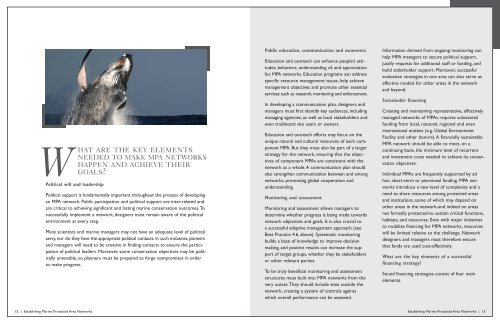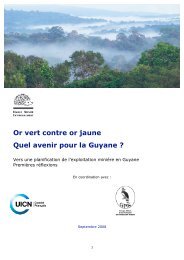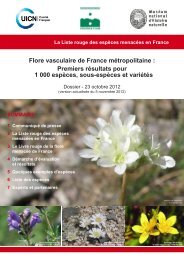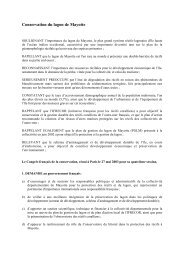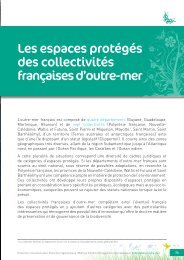Establishing Marine Protected Area Networks - Georgia Strait Alliance
Establishing Marine Protected Area Networks - Georgia Strait Alliance
Establishing Marine Protected Area Networks - Georgia Strait Alliance
You also want an ePaper? Increase the reach of your titles
YUMPU automatically turns print PDFs into web optimized ePapers that Google loves.
WHAT ARE THE KEY ELEMENTS<br />
NEEDED TO MAKE MPA NETWORKS<br />
HAPPEN AND ACHIEVE THEIR<br />
GOALS?<br />
Political will and leadership<br />
Political support is fundamentally important throughout the process of developing<br />
an MPA network. Public participation and political support are inter-related and<br />
are critical to achieving significant and lasting marine conservation outcomes.To<br />
successfully implement a network, designers must remain aware of the political<br />
environment at every step.<br />
Many scientists and marine managers may not have an adequate level of political<br />
savvy, nor do they have the appropriate political contacts. In such instances, planners<br />
and managers will need to be creative in finding contacts to ensure the participation<br />
of political leaders. Moreover, some conservation objectives may be politically<br />
untenable, so planners must be prepared to forge compromises in order<br />
to make progress.<br />
Public education, communication and awareness<br />
Education and outreach can enhance people’s attitudes,<br />
behaviors, understanding of, and appreciation<br />
for, MPA networks. Education programs can address<br />
specific resource management issues, help achieve<br />
management objectives and promote other essential<br />
services such as research, monitoring and enforcement.<br />
In developing a communication plan, designers and<br />
managers must first identify key audiences, including<br />
managing agencies, as well as local stakeholders and<br />
even traditional site users or owners.<br />
Education and outreach efforts may focus on the<br />
unique natural and cultural resources of each component<br />
MPA. But they must also be part of a larger<br />
strategy for the network, ensuring that the objectives<br />
of component MPAs are consistent with the<br />
network as a whole.A communication plan should<br />
also strengthen communication between and among<br />
networks, promoting global cooperation and<br />
understanding.<br />
Monitoring and assessment<br />
Monitoring and assessment allows managers to<br />
determine whether progress is being made towards<br />
network objectives and goals. It is also crucial to<br />
a successful adaptive management approach (see<br />
Best Practice 4.6, above). Systematic monitoring<br />
builds a base of knowledge to improve decision<br />
making, and positive results can increase the support<br />
of target groups, whether they be stakeholders<br />
or other relevant parties.<br />
To be truly beneficial monitoring and assessment<br />
structures must built into MPA networks from the<br />
very outset.They should include sites outside the<br />
network, creating a system of controls against<br />
which overall performance can be assessed.<br />
Information derived from ongoing monitoring can<br />
help MPA managers to secure political support,<br />
justify requests for additional staff or funding, and<br />
build stakeholder support. Moreover, successful<br />
evaluation strategies in one area can also serve as<br />
effective models for other areas in the network<br />
and beyond.<br />
Sustainable financing<br />
Creating and maintaining representative, effectively<br />
managed networks of MPAs requires substantial<br />
funding from local, national, regional and even<br />
international entities (e.g. Global Environment<br />
Facility and other donors).A financially sustainable<br />
MPA network should be able to meet, on a<br />
continuing basis, the minimum level of recurrent<br />
and investment costs needed to achieve its conservation<br />
objectives.<br />
Individual MPAs are frequently supported by ad<br />
hoc, short-term or piecemeal funding. MPA networks<br />
introduce a new level of complexity and a<br />
need to share resources among protected areas<br />
and institutions, some of which may depend on<br />
other areas in the network-and indeed on areas<br />
not formally protected-to sustain critical functions,<br />
habitats, and resources. Even with major initiatives<br />
to mobilize financing for MPA networks, resources<br />
will be limited relative to the challenge. Network<br />
designers and managers must therefore ensure<br />
that funds are used cost-effectively.<br />
What are the key elements of a successful<br />
financing strategy?<br />
Sound financing strategies consist of four main<br />
elements.<br />
12 | <strong>Establishing</strong> <strong>Marine</strong> <strong>Protected</strong> <strong>Area</strong> <strong>Networks</strong> <strong>Establishing</strong> <strong>Marine</strong> <strong>Protected</strong> <strong>Area</strong> <strong>Networks</strong> | 13


